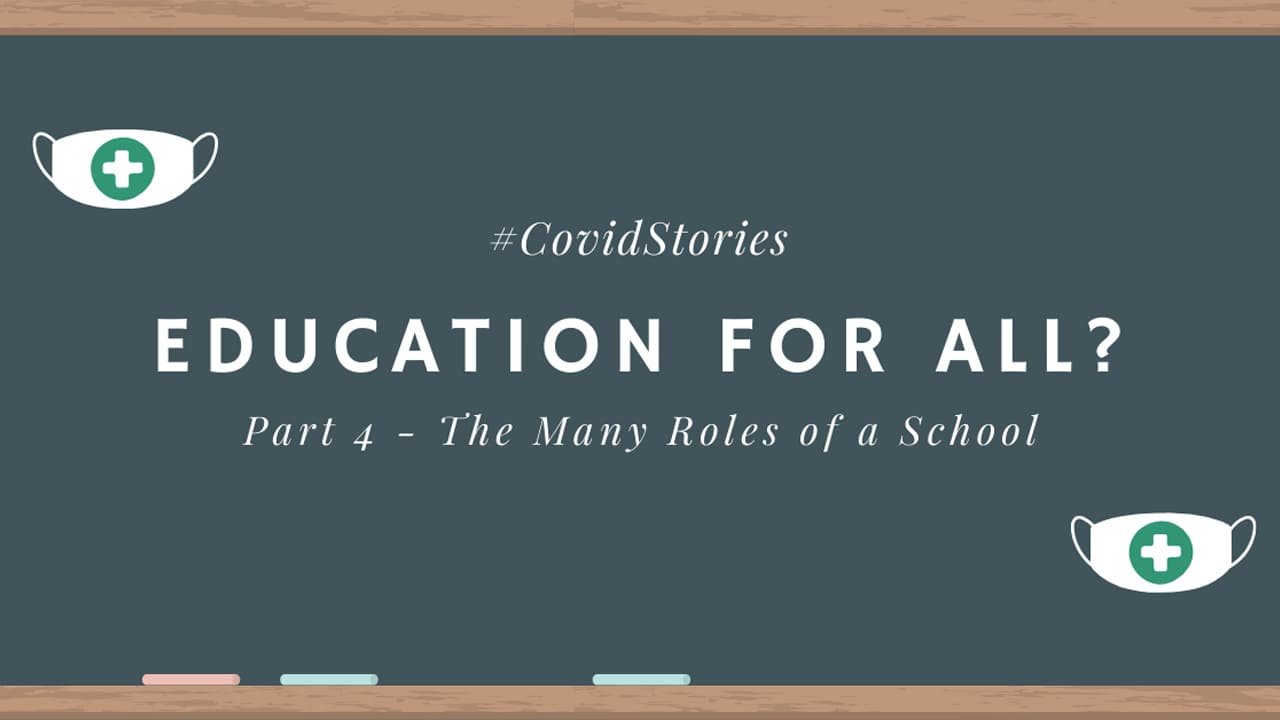#4 Beyond Education
Dr Pravin Patkar
Director, Anti-Trafficking Center
Azra Qaisar
Senior Project Co-ordinator
With schools having been closed for over two months now, the impact will be seen not only on education but in other spheres as well. A school is an integral part of a child’s life whose role goes much beyond providing education. It introduces the child to a structured approach to education and also plays a role in the social and psychological development of the child. Schools help the children in socializing through interactions with teachers, staff members, and fellow students. They facilitate learning from peers and pave the way to explore extra-curricular activities. When schools close, many children and youth miss out on social contact which is essential to learning and development.
Nutrition and Sanitation
In India, there has been a serious and unquestionable admission of the importance of the connection between education and its pre-requirements like nutrition, sanitation, drinking water, handwashing facilities, toilets, etc. Around the year 1995, the central government in response to an Order of the Supreme court in a Writ Petition announced a nationwide Mid-Day Meal program. It was agreed by all that a large number of children do not have enough to eat and hence their attendance at school and their attention in the class suffers adversely. Hot cooked meals as mid-day meals became an instant hit and incentivized children to attend school. It was reflected in higher attendance of children from the marginalized sections of the society. It has also been observed that the education of girl children gets drastically affected as they hit puberty since the infrastructure at home as well as at schools is not sensitive to their needs for menstrual hygiene. The country also took a serious note of the need for proper sanitation at schools and the provision of sanitary napkins for girls between 10 and 19 in 2011. This was based on the realization that schools and the education delivered through them serve as effective growth impulses for children.
Schools, Colleges, Ashram schools, Aanganwadis all have been shut down and a large number of children have been forced to stay at home. As mentioned in our previous post, in March 2020 the State Govt of Maharashtra had asked Anganwadis to home-deliver the share of the food grains to the families of the Anganwadi children. However, how far are the workers being able to reach with restrictions in movement is not known yet.
Inequalities amplified by the lockdown
Disadvantaged children and youth will be the hardest hit by school closures but what makes a child disadvantaged or excluded has changed over the years. In the current times, lack of access to Information and communication technologies as mentioned in our last post can put a child at a considerable disadvantage especially amid the current crisis.
Apart from the digital divide, there are other situations for children where a temporary break in education might become a permanent exit. In cases, where a child is already not keen on pursuing an education, a break might lead them to drop-out and dissuade them to start again. In cases where a lot of effort has gone into convincing the families to admit the child in a school, the families might not be willing to let the child go to school later. This is a real possibility if the family is in a poor financial state and needs the child to earn, or if the parents need to earn and require the child to be a caregiver to their younger siblings. For girl students, a break in their education might also lead to early marriage, being forced to join the labor force and an increased risk of being pushed into commercial sexual exploitation to generate income for the family.
The following effects might be visible because of the impact on education in the current situation :
- Nutrition – In cases where the child was getting mid-day meals from the school or staying at an Ashram school (as mentioned in our previous post), their nutritional requirements are now an extra burden on the families, who might already have limited resources. For children, who have been staying with their families, there will also be a deprivation in their nutrition.
- Sanitation and health – Children who live in tribal schools may not be able to access toilets, bathing places upon return to their homes. Girl children may not have access to sanitary napkins away from schools.
- Safety and Protection – The physical safety of a child during the day time will be affected. The children may or may not have an adult supervising them at home all day. Additionally, this could also burden an older sibling with the responsibility to be a care-giver for their younger siblings. This could affect their education and even lead them to eventually drop-out after the lockdown. In situations where the child is facing abuse or exploitation, seeking help becomes very difficult and the child is forced to live with their abuser.
- Education & Learning – They may have no access to ICT, hardware & Software to access online education, affecting their right to education and putting them at a disadvantageous position.
- Availability of the child for online education – A child might be compelled to earn to supplement the family income during and after the COVID crisis. There are also technological and socio-economic barriers to accessing online education for many children in India.
- Socialization – Parents and guardians will be forced to spend more time earning a livelihood. In the absence of the socialization provided by the school, they might be unable to give the minimum required socializing inputs to the child. This would affect the growth and development of the child, and also affect their mental health.
- Vulnerability – Many hard-pressed families will push children to earn through exploitative means making them vulnerable.
As stakeholders, policymakers, and lawmakers plan to mitigate the crisis, it is crucial that they remember these concerns of the children in mind. Maharashtra has proposed using television and radio to air lessons for the children who are not privileged to access digital technologies. It is a move geared to promote inclusivity and could help children to access education even if they go back to their native states.
Children will be one of the most severely affected groups of the pandemic and their needs and concerns must not be overlooked. Plans cannot be made by including only a certain section of children and wiping the others off the map and children across various socio-economic groups must be included in the recovery. There is a huge risk of social inequalities being amplified after the crisis passes by. It is essential then that our responses don’t forget those who are at the most risk of being invisibilized and forgotten.
This blog is the last and fourth part of our series “Education for All?”, where we will discuss the impact of the lockdown on education. Through this series, we hope to provide a quick understanding of the obvious repercussions of the lock-down brought by the spread of Covid-19 on education.









Follow